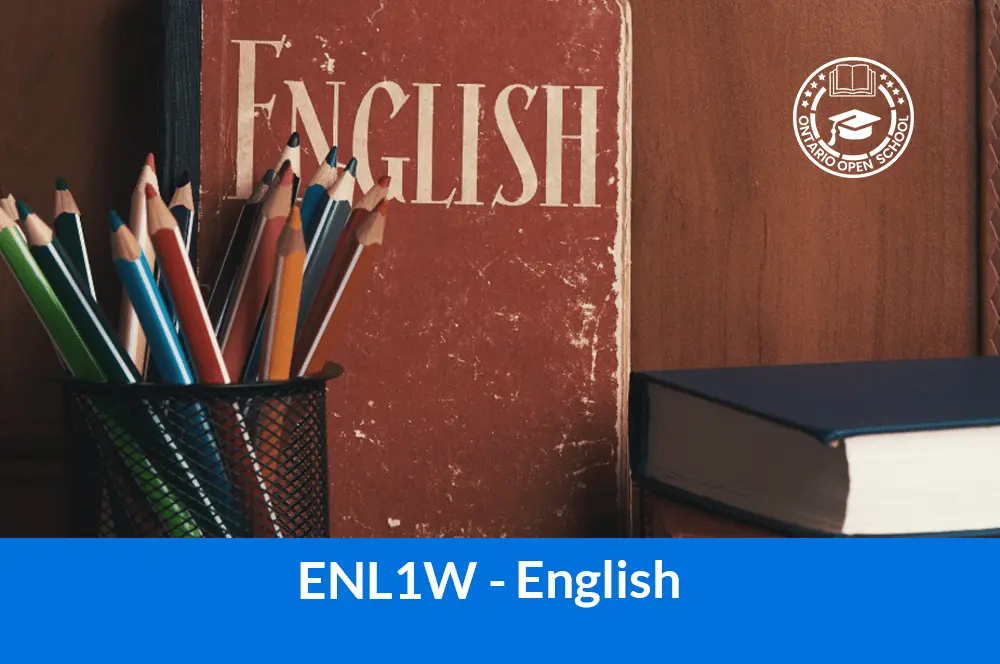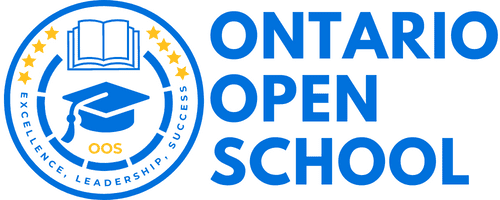- info@ontarioopenschool.com
- 647-494-4499
-
Unit 100 - 29 Gervais Drive, North York, ON.
M3C 1Y9
Copyright 2024 Ontario Open School Inc. All Rights Reserved.
This course enables students to continue to develop and consolidate the foundational knowledge and skills that they need for reading, writing, and oral and visual communication. Throughout the course, students will continue to enhance their media literacy and critical literacy skills, and to develop and apply transferable skills, including digital literacy. Students will also make connections to their lived experiences and to society and increase their understanding of the importance of language and literacy across the curriculum.
Unit Order | Unit Name | Suggested Time |
|---|---|---|
| Unit 1 | Practical Literacy Skills : | 15 hours |
| Unit 2 | For the Love of Reading : | 28 hours |
| Unit 3 | Connections with Media : | 20 hours |
| Unit 4 | We Are All Different : | 25 hours |
| Unit 5 | Final Culminating Activity : | 20 Hours |
| Final Evaluation 30% | Final Project Students will reflect on their learning in ENL1W. Responding to several questions, students will | 2 hours |
| Total | 110 Hours |
A variety of strategies are used to allow students many opportunities to attain the necessary skills for success in this course. The teacher uses a variety of whole class, small group and individual activities to facilitate learning. The following is a list of specific teaching/learning strategies that the teacher may use but is not limited to:
Presentations with embedded videos are used to outline concepts, explain theory using examples and practice questions, and incorporate multi-media opportunities for students to learn more (e.g. online simulations, quizzes, etc.).
End of unit conversations are opportunities for students to express their ideas, problem solving, and thought processes with a teacher who provides timely feedback.
Reflection is an opportunity for students to look back at concepts and theories with new eyes, to relate theory to practice, and to align learning with their own values and beliefs.
Discussions with the instructor are facilitated through video conferencing, discussing the concepts and skills being studied. This enables two-way communication between the student and the instructor, to share ideas and ask questions in dialogue. This also helps to build a relationship between the student and instructor.
Instructor demonstrations (research skills, etc.) are opportunities for the instructor to lead a student through a concept or skill through video conferencing, videos, or emailing with the student.
Discussion forums are an opportunity for students to summarize and share their ideas and perspectives with their peers, which deepens understanding through expression. It also provides an opportunity for peer-to-peer feedback.
Practical extension and application of knowledge are integrated throughout the course. The goal is to help students make connections between what they learn in the classroom and how they understand and relate
to the world around them and their own lives. Learning becomes a dynamic opportunity for students to be more aware that their learning is all around them and enables them to create more meaning in their lives.
Individual activities/assignments assessments are completed individually at a student’s own pace and are intended to expand and consolidate the learning in each lesson. Individual activities allow the teacher to accommodate interests and needs and to assess the progress of individual students. For this reason, students are encouraged to discuss IEPs (Individual Education Plans) with their teacher and to ask to modify assessments if they have a unique interest that they feel could be pursued in the assessment. The teacher plays an important role in supporting these activities by providing ongoing feedback to students, both orally and in writing.
Research is an opportunity to apply inquiry skills to a practical problem or question. Students perform research to gather information, evaluate quality sources, analyze findings, evaluate their analysis, and synthesize their findings into conclusions. Throughout, students apply both creative thinking and critical thinking. New questions are also developed for further learning.
Writing as a learning tool helps students to think critically about course material while grasping, organizing, and integrating prior knowledge with new concepts. Good communication skills are important both in and out of the classroom.
Brainstorming, charts, and graphs are a great way for students to synthesize their knowledge of subject matter visually through graphic organizers, pictures, and texts.
Readings are an opportunity for students to gain insight from a variety of texts online and further develop literacy skills. Students may print out the reading material to use to highlight, take notes, and have with them when a computer is not available.
Articles are examples of concepts and theories being discussed in the public realm and with respect to current events. They are snapshots not only of why theories/concepts/applications are relevant but also provide a window into the broader context of subject matter knowledge and understanding. Students learn through reading and analysis that the subject matter is deeply related to, and intertwined with, society and the diverse perspectives of lived experience.
Oral presentations in an online environment are opportunities for students to present live or recorded presentations, expressing their ideas and understanding orally.
Reflective/comparative analysis and evaluation of written work is very important in this course. Concepts and skills are modelled in examples (exemplars), which students can refer to and utilize to self-evaluate their own work. A variety of texts are shared, and students are encouraged to make comparisons with different texts, real life situations, and their own writing.
Journals provide an opportunity for students to self-reflect on the subject matter and see their growth over time. It supports students to express their thoughts and skills learned in a personal way.
Purpose
The primary purpose of assessment is to improve student learning. Assessment relates directly to the expectations for the course.
A variety of assessments for and as learning are conducted on a regular basis to allow ample opportunities for students to improve and ultimately demonstrate their full range of learning and for the teacher to gather information to provide feedback. Assessment tasks relate to the success criteria set out in lesson plans. Success criteria allow students to see what quality looks like.
Evaluation is the process of judging the quality of student work in relation to the achievement chart categories and criteria and assigning a percentage grade to represent that quality. Evaluation is based on gathering evidence of student achievement through:
Assessment for Learning – we provide feedback and coaching. Assessment FOR Learning is the process of seeking and interpreting evidence for the use of learners and their teachers to decide where the learners are in their learning, where they need to go, and how best to go there.
Assessment as Learning – we help students monitor progress, set goals, reflect on their learning
Assessment AS Learning is the process of the explicit fostering of students’ capacity over time to be their own best assessors, but teachers need to start by presenting and modeling external, structured opportunities for students to assess themselves.
Assessment of Learning – we use assessments to provide evaluative statements about student achievement. Assessment OF Learning is the assessment that becomes public and results in statements of symbols
(marks/grades/levels of achievement) about how well students are learning. It often contributes to pivotal decisions that will affect students’ future.
ASSESSMENT TOOLS
Assessment practices can nurture students’ sense of progress and competency and information instruction. Many diagnostic tools, e.g. checklists, are used at regular intervals throughout the units to encourage students’ understanding of their current status as learners and to provide frequent and timely reviews of their progress. Assessment of student acquisition of learning skills also occurs regularly through unobtrusive teacher observation and conferencing.
Teachers are encouraged to share goals with students early in the course and to connect unit learning experiences frequently and explicitly with big ideas, overall expectations, and performance tasks. The teacher is encouraged to involve students in the discussion, modification, or creation of rubrics, and teach students to use rubrics as a learning tool.
Resources
Growing Success: Assessment, Evaluation and Reporting in Ontario Schools (2010)
http://www.edu.gov.on.ca/eng/policyfunding/growSuccess.pdf
Novel: Skud by Dennis Foon or The Chrysalids by John Wyndham
School online material
Dictionaries, Thesaurus etc.
Various Daily Newspapers, Magazines, and Periodicals
Grading
Weighting of categories
| Knowledge/Understanding | Thinking/Inquiry | Communication | Application |
| 25% | 25% | 25% | 25% |
TERM WORK EVALUATIONS (70%)
|
Evaluation Item |
Description | Category | Weight |
|
Unit 1 |
K, T, C, A | ||
|
Paragraph Writing Assignment |
K, T, C, A |
7.5 |
|
| End of Unit Evaluation | K, T, C, A |
10 |
|
|
Unit 2 |
Quotation Response #4 | K, T, C, A | 7.5 |
|
Final Evaluation Task Written |
K, T, C, A |
5 |
|
| Final Evaluation Task Oral | K, T, C, A |
5 |
|
|
Midpoint of the course |
|||
|
Unit 3 |
Persuasive Essay Assignment | K, T, C, A | 10 |
|
Discussion Post |
K, T, C, A |
5 |
|
| Messages in Media Presentation | K, T, C, A |
10 |
|
| Unit 4 | The Hockey Sweater Worksheet | K, T, C, A |
10 |
FINAL EVALUATIONS (30%)
|
Final Evaluation |
Description | Category | Weight |
|
Final Project |
Culminating Activity | K, T, C, A | 10 |
| Final Exam | Final Exam covers all units | K, T, C, A |
20 |

Course Grade | Grade 9 |
|---|---|
Course Code | ENL1W |
Course Category | English |
Course Type | De-Streamed |
Course Delivery | Online |
Course Duration | 110h |
Course Credit | 1.00 |
Copyright 2024 Ontario Open School Inc. All Rights Reserved.
